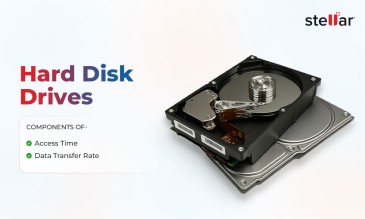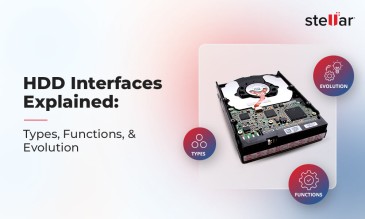If you’ve accidentally deleted some files or lost a partition on your hard drive, your first thought might be to run a professional data recovery software. For issues like deletion or formatting, these tools work well on most traditional hard drives.
But if your drive uses SMR (Shingled Magnetic Recording) technology—which many modern high-capacity drives do—you will find that software recovery tools return empty-handed. And depending on how valuable the data is, your response could range from mild distress to full-blown panic!
Here’s the good news, though.
Your data is usually still there. The difference is that SMR drives organize and store data differently, so data recovery software cannot read or reconstruct it.
That’s why, if you own a Western Digital SMR drive, your best bet is to contact a professional data recovery service like Stellar. Our experts use specialized tools to recover data safely from SMR drives—even when software can’t.
But before we explain how we recover data from SMR drives, let’s first understand why data recovery software fails on SMR drives.
Why Your Data Recovery Software Fails on SMR Hard Drives
To understand why software fails on SMR drives, it helps to know how hard drives store data and, specifically, the difference between older CMR (Conventional Magnetic Recording) and newer SMR technologies.
Note: If you are unfamiliar with the design and working of a hard disk drive, refer to our article on the components of a hard drive.
Imagine the surface of an old vinyl record, with grooves spiraling around the disc. Hard drive platters have similar magnetic tracks.
In CMR, these tracks are written side-by-side, with a tiny buffer strip between them.
The write element must be wider so it can generate a strong enough magnetic field. The read element is narrower as it only needs to sense the field.
Because the write head is chunky, engineers leave a tiny buffer strip between tracks to stop one write from overlapping with the next.
.jpg)
This buffer prevents one write operation from "smearing" or affecting the data on an adjacent track. It's like having separate, distinct lanes on a highway for each row of cars, with narrower, no-traffic lanes in between.
This design allows any sector on a track to be overwritten individually. This also makes data recovery straightforward for software.
What Was the Need for a Better Recording Technology?
By 2010, packing tracks closer had hit physical limits. To store more gigabytes without adding platters (which make drives thicker, heavier, hotter, and costlier), manufacturers needed a fresh idea.
Enter Shingled Magnetic Recording (SMR)
The innovative breakthrough with SMR was to let the write head—which is wider than the read head—overlap with what it had just written, much like how roof shingles overlap.
- Track #1 is laid down full width.
- The actuator nudges sideways less than one head-width.
- Track #2 is written, trimming a little from the edge of Track #1 but leaving a clean center strip that the narrow read head can still follow.
Repeat this hundreds of thousands of times, and you get a much tighter “track pitch” and about 11–20% higher areal density on the same platter surface.
.jpg)
The image above shows this geometry: the dark band is the part that remains readable after the overlap, while the pale area shows the portion that has been trimmed away.
In the next image you can see entire zones—bundles of overlapping tracks treated as a single unit.
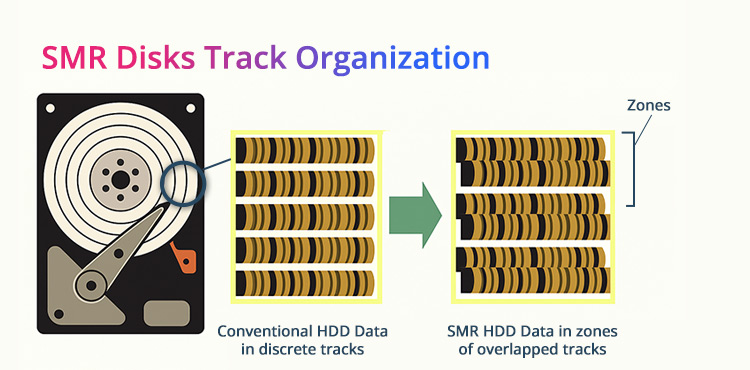
The arrangement looks very similar to how shingles are arranged on a roof.
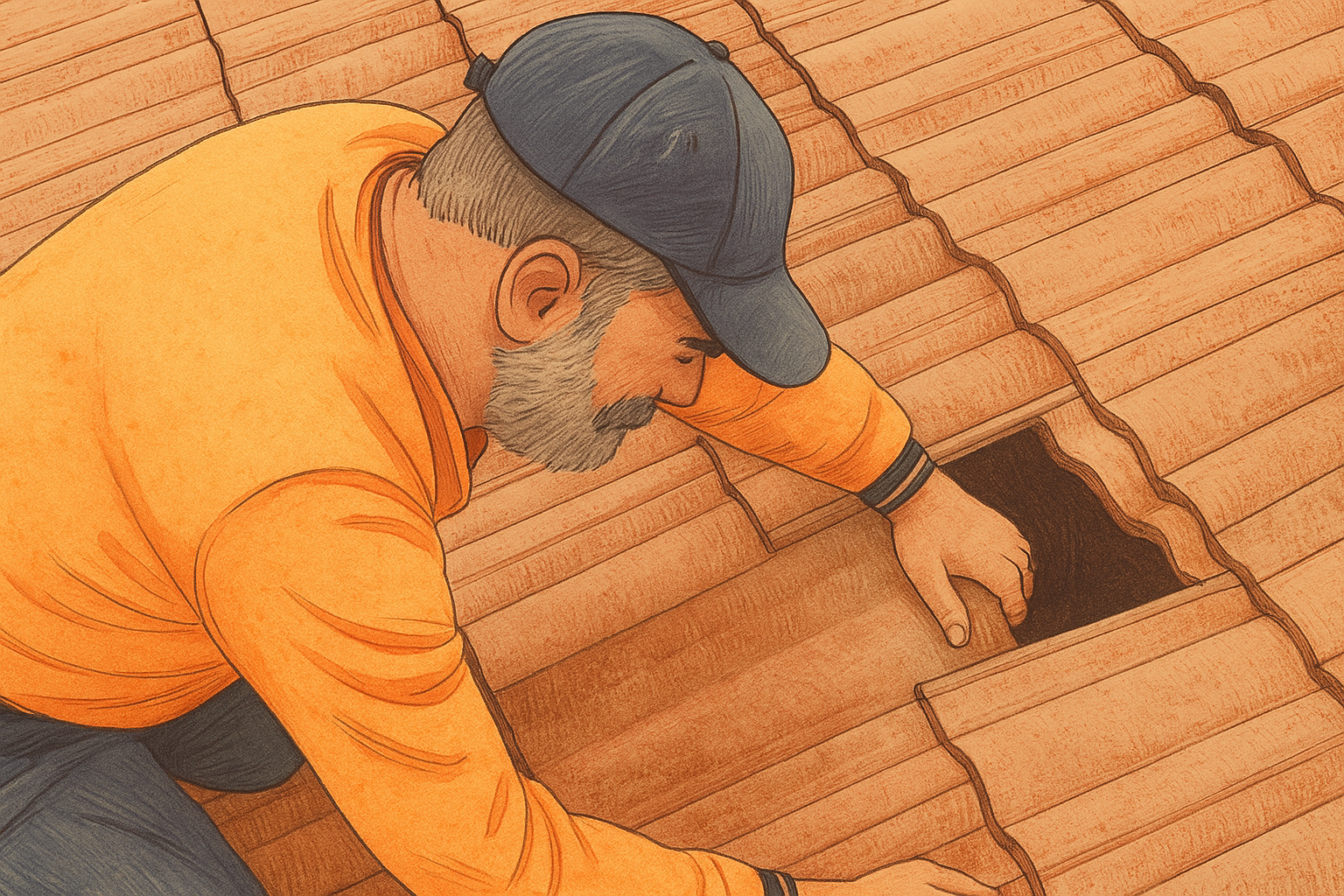
But this track overlap also creates the need for new read/write rules.
Because Track #3 (let’s say) partly covers Track #2, you cannot simply rewrite a few sectors on Track #2 without rewriting everything on the track above them.
SMR firmware therefore groups—perhaps—256 KB worth of tracks into a zone (also called a band). If even one 4 KB sector changes, the controller:
- Reads the whole zone into cache;
- Updates the changed sector; and
- Rewrites the entire zone sequentially.
That constant shuffle is hidden from your PC by two firmware maps, often called a double translator:
- Translator 1 (LBA map): where your operating system thinks the data lives.
- Translator 2 (Zone map): where the data actually ended up after each shuffle.
If either table is damaged, the drive returns zeros even though the magnetic data is still present.
Now, when your computer asks a drive for data, it uses a Logical Block Address (LBA)—think of it as a directory of street numbers your operating system understands.
Inside the drive, however, that same data lives at a Physical Block Address (PBA)—the real position on the platter where the bits sit.
This is how it looks on a CMR drive.
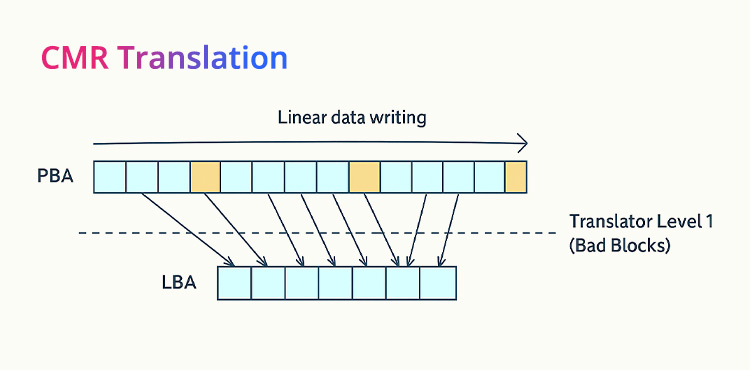
Observe that:
- LBAs increase in a tidy line: 0-1-2-3-4-5 …
- When a sector on a CMR disk goes bad, the drive’s firmware marks that physical spot as “bad.”
- A single firmware table—Translator 1—keeps track of bad blocks and minor shifts.
- The drive’s firmware allocates a spare sector located elsewhere on the platter and tells Translator 1 to point the affected LBA to this new, healthy PBA.
Because the mapping is simple, software that scans LBAs can usually rebuild deleted files.
So what changes on an SMR drive? To understand, refer to this image.
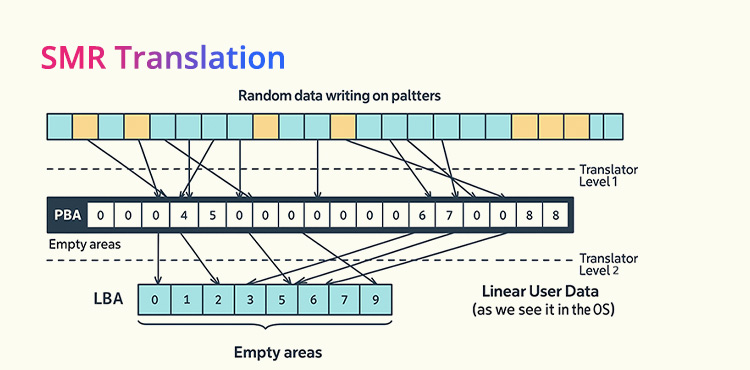
SMR’s “roof-shingle” layout forces the firmware to shuffle data in big zones. After every rewrite, it updates a second map (Translator 2) that tells the drive where each LBA really landed among the overlapped tracks.
If either table is corrupted, the drive shows zeros for whole ranges of LBAs even though the magnetic data is still present on the platter.
This is why generic data recovery software struggles.
- It can't "see" the raw data: Software relies on the drive's internal translators to locate files. If these translators are damaged or wiped (as often happens with SMR), the software can't find anything.
- It can cause more damage: Every scan or attempt to "fix" an SMR drive with standard software forces the firmware to juggle entire zones. This can accelerate the purging of deleted sectors during background zone resets, making recovery impossible. It can also stress already fragile heads or firmware that might be struggling with the double-translator map, leading to further physical damage.
Note: To stop zones from filling with stale fragments, the drive periodically performs a “zone reset” (also called RESET WRITE POINTER in the SATA/SCSI ZAC/ZBC specs). It rewrites the entire band in one go, discarding any sector the file system had already marked as deleted—similar in spirit to (but not the same as) the TRIM command on SSDs. Once a zone is reset, those deleted bytes are gone for good.
In short, while SMR is a clever way to fit more data, its overlapping nature, double translator, and automatic zone resets make DIY software recovery a near impossibility.
A specialist recovery service such as Stellar Data Recovery bypasses all of that risk by working on the drive outside the normal command set with tools that can directly access the Physical Block Address.
FAQs
Yes—provided the platters are intact. We transplant working heads/PCBs in a Class 100 cleanroom and image the disk at reduced speed. Many “dead” drives come back to life long enough for imaging.
Unfortunately, no. Once a zone is rewritten or the translator data is reset, there is no residual data for software to scrape. Only a lab that can read raw shingled tracks has a chance.
Look up the model number on the manufacturer’s spec sheet—e.g., WD WD40EZAZ or Seagate ST4000DM004 are both listed as SMR.
About The Author

Somdatta is a professional content writer and analyst focused on the storage technology sector, with expertise in both magnetic and flash storage, as well as cloud computing and virtualization concepts. Somdatta translates technical concepts into clear, engaging content to sensitize readers toward a multitude of data loss scenarios and help them gain insights into the nuances of data recovery.






